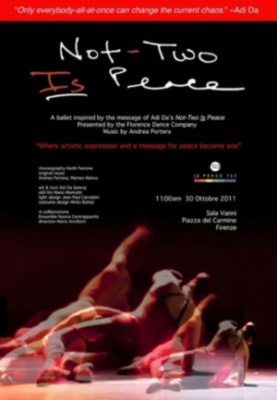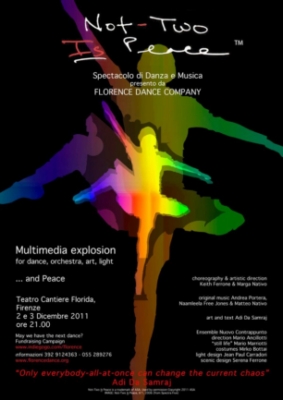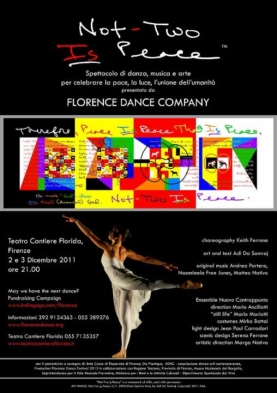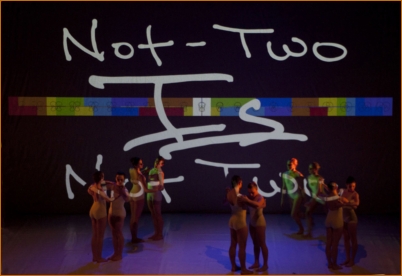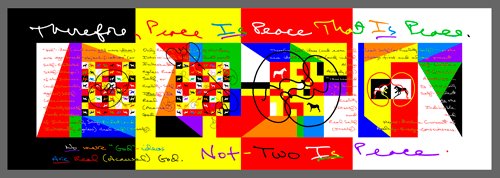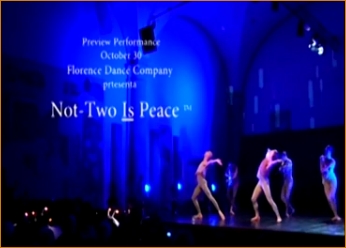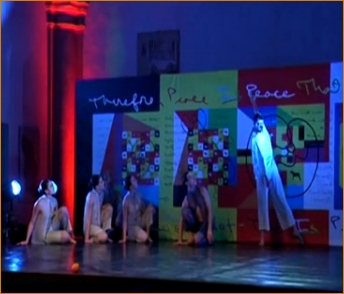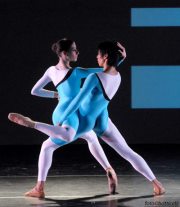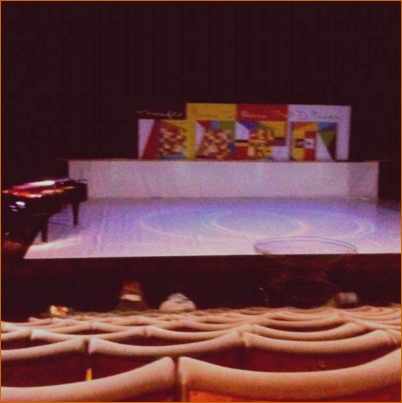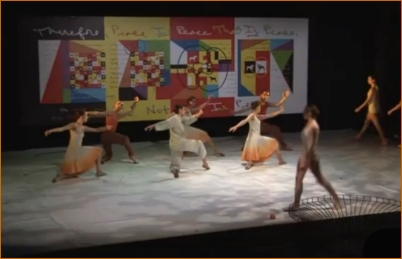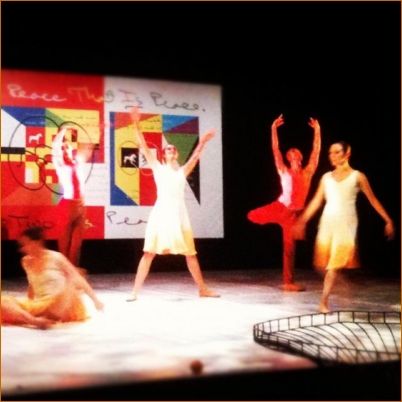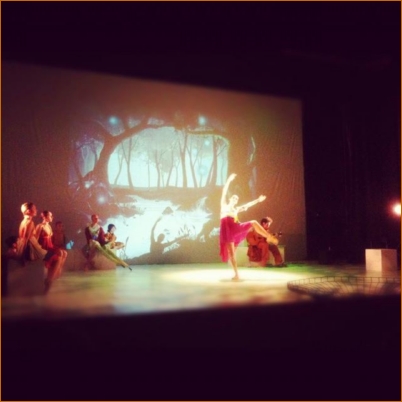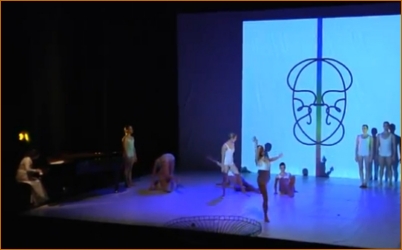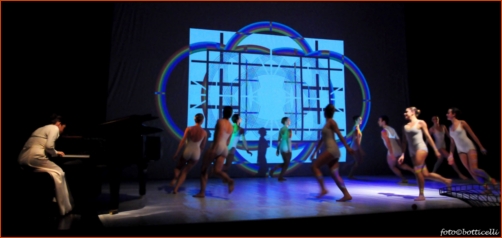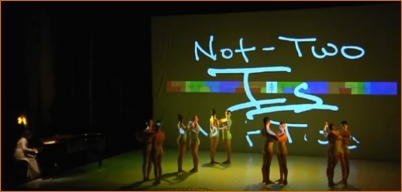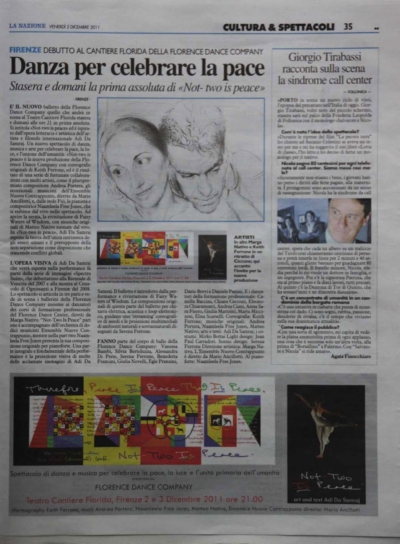|
| |||||||||||||||
 | Mary Murfin Bayley is a freelance arts writer. She was the dance critic for the Seattle Times from 1997 to 2007. |
In
Not-Two Is Peace, based on the book and artistic images
of the same name by Adi Da Samraj, choreographer Keith Ferrone takes the images
of Adi Da, with their complex geometric shapes, arrays of color, and meditative
layers of meaning, and gives them theatrical shape.
There are historic precedents for inspired collaborations between choreographer and painter, such as Chagall with Massine or Rauschenberg with Trisha Brown. In his third major work inspired by Adi Da (the first was the 2009 "Four Seasons", the second, 2010 "Divina.com" - Dante/Adi Da Samraj/ Florence), Ferrone builds further on this collaborative tradition. With the use of light, sculpture, video, and music he converts the medium of painting into a dynamic new form.
With Jean Paul Carradori's lighting design and Ruy Carpenter's video, Adi Da's images are projected not only on the set but on both sides of the auditorium, thereby surrounding the audience with the artist's world of light, color and contemplativeness. The music by Andrea Portera, played beautifully the night I saw it by the Ensemble Nuovo Contrappunto (under the direction of Mario Ancillotti), brought further color and shape to the dance.
The interaction of dancers, with color, costume, light and set are specific and evocative. The costumes, designed by Mirko Bottai, are sometimes used to suggest altered states of being, enlightenment perhaps, or the body after death.
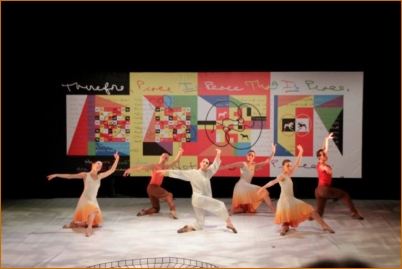
Performance
(click
picture for enlargement)
In one section when the dancers strip down onstage, they imbue the bundles of clothes in their hands with a sense of deep tenderness. Slowly they drop the clothes they have just removed over the edge of the stage as if dropping something living into a ditch. When a few minutes later the dancers arrange themselves in a large basket structure (a metal sculpture entitled "Still Life" by artist Mario Mariotti), their intertwined limbs and the yellow light that plays over their sprawled shapes makes us think of executed bodies in a pit, or heaped on a cart, a horrifying and powerful image of war. Those clothes that have just been dropped so reluctantly over the edge become part of the horror; Ferrone doesn't shy away from this grisly image. He leaves us to look at the perfectly still bodies for several minutes while Andrea Portera's lush score speaks to us with depth and sadness.
The transition that follows brings a startling contrast, leading us into a sequence that becomes an exhilarating evocation of joy over horror. The music turns light, flute-like and hopeful. A large background image of Adi Da's image, "Not-Two Is Peace", is revealed with its dense array of bright colors and written words. The dancers on stage clothe themselves in bright orange costumes while files of other dancers wearing white walk into the audience carrying wooden crates and handing out oranges. As audience members accept the oranges and begin to peel them, the cheerful scent of citrus becomes part of the brightness. The color orange is given the shape of another sense. It is an original, visceral evocation of happiness.
Ferrone's movement vocabulary, like his sense of theater, is inclusive and varied. It is primarily classically based (the Florence Dance Company Dancers are ballet trained), but is also purely "post-modern" in its variety, including folkloric elements, contemporary pedestrian gestures, and references to various ethnic dance forms. Ferrone uses the full range of movement and rhythm, from expansive buoyant leaps to tiny psychological tics such as flicking or shaking. When a dancer at one point takes a marker and writes a phrase over and over again on the projected painting, we are as caught by the vivid attack of her body's line and the movement of her arm as we are by the words she writes.
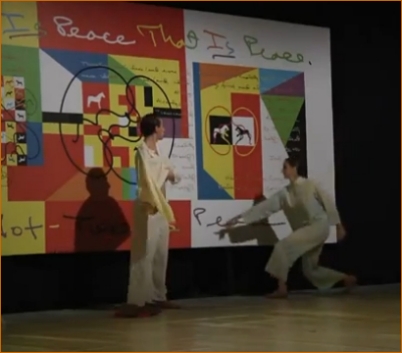
Performance
In the second half of the ballet, entitled "Peace Is Peace That Is Peace", composer Naamleela Free Jones plays her original composition on an onstage piano. Dressed in white like the dancers, her presence became an essential element of the work.
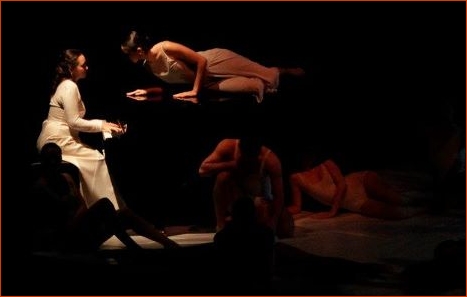
Performance
This section felt more abstracted and purely geometric, as if the dancers had moved into a mystical or cosmic realm. The central image was of a circle, sphere or planet. This shape, reflected in video images and light, was a repeated motif of the movement. The dancers circled and spiraled, both through space but also in the shaping of their own bodies, reflecting the interlocking hoops of Adi Da's projected image.
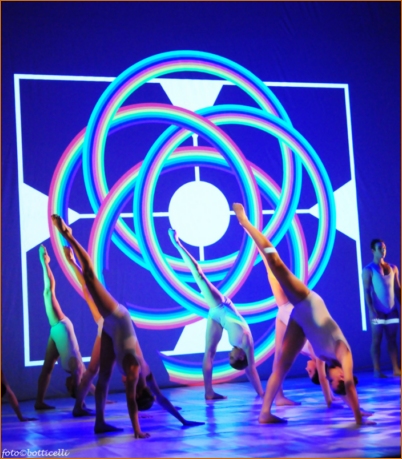
Performance
(click
picture for enlargement)
In the final image of the evening, the dancers form into a simple circle. Then they slowly open it out to include the other artists, musicians, and designers. It is a beautiful curtain call, and as these individuals come onstage in ones and twos and join the circle, it becomes a simple and satisfying dance in itself. The final moment leaves a strong impression of the ways in which the meaning of both life and of art are found in community and connection. (Perhaps the "one-ness" implied in the name "Not-Two Is Peace.")
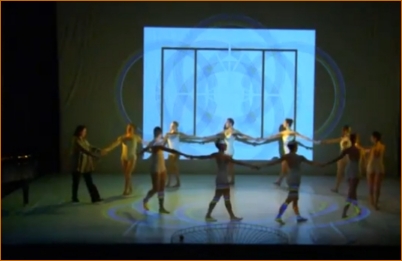
Performance
(click
picture for enlargement)
Ferrone's collaboration with Adi Da raised (at least for me) questions about the relationship of art to philosophy and spirituality. Adi Da Samraj was a mystic and philosopher as well as an artist, and this element is caught and conveyed with texture and clarity in Ferrone's work. It is one of the pleasures of good dance that it is complete in itself and does not need any meaning other than the dancer in space. When it is linked to the vision of other artists — as it is here with Adi Da's images, with Carradori's light, Carpenter's videos, and the music of Portera and Free Jones — dance becomes one of the most potent and exhilarating art forms available to us.
Dance is simply human beings moving through light. Music is time and melody. Artistic images are colors and forms in space. What these things mean when they are playing out in a theatrical work is whatever the viewer or listener experiences. Whether these forms are legitimately used to express a religious conviction is a different question. They have done so in the past. But what we are looking for as contemporary viewers and theater goers is to experience these visions, or even these religious revelations ourselves, by focusing on the art form. When we look at Adi Da's work, we do not need to know that he was a spiritual teacher. This is an irrelevance and a distraction. All we need is to be open to the work of art and the vision will (or will not) come through to us.
In this work, the revelation of peace is experienced because Ferrone has the courage to leave the bodies on stage in absolute stillness for an unexpectedly long time. This gives the movement and light that follows its joyful vision of a world without war and hatred. Just so, his use of circles and circular movement creates a vision of oneness. Each form of art offers its own enlightenments. The revelations we get from Adi Da's work are because he created images of color and form. There may be other revelations to be gotten from his writings and teachings, but the revelations of art can only be gotten from the art itself. A work of art can't be defined or meanings parsed by anyone other than the person in the audience or in front of the artwork who experiences it. This is where the visions come. Keith Ferrone's "Not-Two Is Peace" at Florence Dance Center opens the possibility for us.
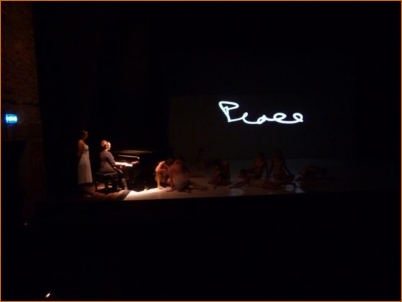
Performance
Photo
courtesy Naamleela Free Jones
(click picture for enlargement)
![]()
This page appears in
Art Events and Exhibitions
and Special Events
| Quotations
from and/or photographs of Avatar Adi Da Samraj used by permission of the copyright
owner: © Copyrighted materials used with the permission of The Avataric Samrajya of Adidam Pty Ltd, as trustee for The Avataric Samrajya of Adidam. All rights reserved. None of these materials may be disseminated or otherwise used for any non-personal purpose without the prior agreement of the copyright owner. ADIDAM is a trademark of The Avataric Samrajya of Adidam Pty Ltd, as Trustee for the Avataric Samrajya of Adidam. Technical problems with our site? Let our webmaster know. |
